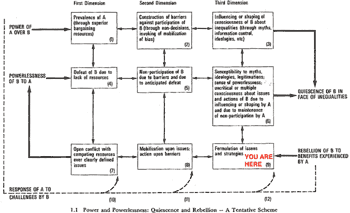May Take A Week And It May Take Longer
I've been reading Power and Powerlessness: Quiescence and Rebellion in an Appalachian Valley by John Gaventa. It's an in-depth investigation into the oppression of coal-mining folk, a real hard look at how people get screwed over. I'm digesting it along with The Great Transformation by Karl Polanyi. Both were gifts from Luke, and I'm working on some new writing partly inspired by these works, and by Dewey's "The Public and it's Problems". And by Kierkegaard's diaries. And my own experience this past year or so. Woof.
But all that BS aside, here's something that's so goddamn useful you can't even fucking believe it -- Gaventa's breakdown of the three dimensions of power and how they act in an oppressive or oppositional context between two actors:
This diagram was set up to explain how a dominant power maintains its power, but you can relatively easily reverse-engineer the situation to figure out what to do if you're the one being fucked with. For instance, let's take a walk through this looking at the two-party system of American self-governance at the national level.
As it stands, Democrats are completely out of power in all three dimensions. These dimensions are explained in the 1, 2 and 3 boxes across the top row:
- Prevalence of Republicans through superior bargaining resources: Pretty obvious. They control the White House and Congress. They have secretaries of state who will mess with the number and quality of voting machines in minority districts for partisan gain. They're working on the Supreme Court. Nuff said.
- Construction of barriers against participation of Democrats (through non-decisions, invoking of mobilization of bias): this has some more wonky language here. Basically it means creating impediments to participation by convincing people it's not worth it, or by mobilizing their biases to misdirect or disenfranchise them. Runs from "soft" voter suppression (misinformation, cynicism, "let them decide" attitude) to the phenomena of people voting against their own interests for "moral" reasons.
- Influencing or shaping the consciousness of Democrats about inequalities (through myths, information control, ideologies, etc): they're kicking ass at message, they have a better media machine, they have dominated the conventional wisdom and framed the debate.
So the Democrats are taking a pounding. Their task is to proceed along the bottom row from right to left: formulating issues and strategies, mobilizing on those issues to act upon the barriers, and then moving into open political conflict with competing resources over clearly defined issues. The challenges they must overcome are on the 4, 5, 6 line.
This is where it gets interesting. In this past election, the Dems defeat was not due to a lack of resources (4). Historically, they are are outspent and out-organized by Republicans to a significant degree, but not so in this election. A case can, and should, be made that their defeat was partially based on the failure to succeed at point 7 just below point 4. The conflict (the election) was not fought over clearly defined issues, and not entirely with competing resources. Specifically, Kerry voted for the war before he voted against it, and there are a number of corporate interests who finance both parties.
However, I see the real meat of the Democrats defeat in the 5 and 6 zone. "Non-participation of Democrats due to barriers and due to anticipated defeat." While voter turnout was up, it wasn't as high as some hoped. It's widely understood that Kerry failed to generate widespread and/or sustained enthusiasm with the base, and many Democrats began privately anticipating defeat several years in advance. Also, while it's unclear whether vote suppression was the decisive factor in the election, it was clearly a contributing factor in at least two key states.
Which brings us finally to box 6, which is where the Democrats take a pants-down spanking. "Susceptibility to myths, ideologies, legitimations, sense of powerlessness, uncritical or multiple consciousness about issues and actions..." Oh man. We all know that one. It is from this abject loss of control over the third dimension of power that all the other failures spring.
So, Democrats, liberals, progressives; whatever you call yourselves, you're down there in the corner with a lot of work to do.
In case you were wondering, I'm right there with you. I'll have more on this in the coming days and weeks, but I think it's helpful just to realize where we are.
P.S. It's also worth noting that the three dimensions of power have many other applications, and this diagram of challenge and response can be applied to any A vs. B conflict. People vs. Corporations. US vs. Terrorist Networks. Any zero-sum conflict (e.g. one in which a negotiated compromise is off the table) between two parties (where a balance of power cannot be created) will play out along these lines. For instance, if you look at US vs. Terrorist Networks, it seems clear that while the US retains the upper hand in the first order of power, it has clearly lost the advantage in the second and third orders, and given that the chances that the Terrorist Networks will be defeated through a lack of resources seems slim. Ooof.
I could go on like this, but it's Saturday. Have a good one.

